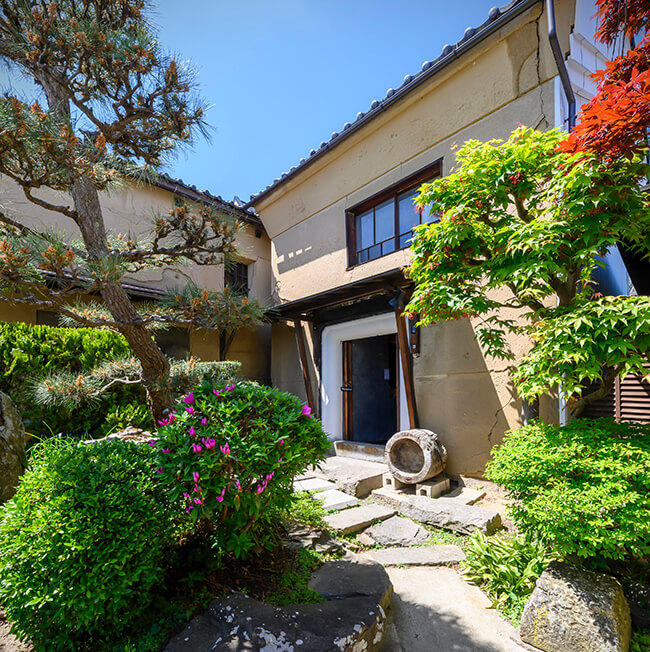24koujiya: Koji Shop of Tradition and Innovation
Nov 14,2024
24koujiya: Koji Shop of Tradition and Innovation
Nov 14,2024


Tucked away in the northeast of the city of Nagano, in the residential neighborhood of Yanagihara a little way from Nagano Station, is a cozy little shop. Identified by a timber sign emblazoned with a logo, it has a stylish, natural-looking exterior. At first glance you might think it’s a cafe or a boutique that sells knickknacks. When you enter, though, the shelves are lined with salted koji and miso. This is 24 koujiya: The Koji Specialists, a retail outlet of Nishi Koujiya Honpo established by its sixth president and his wife. It sells fermented seasonings and sweet fermented amazake beverages made with koji produced at the company’s own factory. Nishi Koujiya Honpo has been making koji since the latter half of the Edo period (1603–1867). We talked to Nishizawa Yoshihiro and his wife Masumi, who launched a new brand in 2020 while still making koji the time-honored way.
The Nishizawas opened a retail outlet and launched their own original brand 24koujiya — in Japanese pronounced “Nishi Koujiya” — in 2020.
“We’ve always focused mainly on wholesale,” explains Masumi. “Still, we would get a lot of customers coming to the factory entrance asking to buy ‘a trayful of koji.’ A trayful means the murobuta or wooden tray in which koji is grown. Each tray contains about a kilogram. Almost everyone who came would use the koji to make their own miso or amazake at home. It occurred to us that having our own store would make things easier for customers wanting to buy. Plus we had no parking lot, which complicated things. Then this lot here by the factory happened to become vacant. We figured we could build a parking lot here, and we decided to open a retail outlet that sold original products make in our factory. One year, we’d had a stall at the Zenkoji Binzuru Market (a market on the precincts of the Zenkoji temple that takes place on the second Saturday of the month between April and November). There we’d sold amazake and salted koji made by hand, so we thought we could draw on that experience.”
The outlet stocks 24koujiya-brand fermented seasonings and miso made with koji, along with kitchenware, shopping bags, and other sundries. It also has a beverage area that sells drinks for on-site consumption or takeout. Here you can enjoy amazake beverages. Each product comes in simply designed packaging featuring just the brand logo. The company wears its long history lightly.
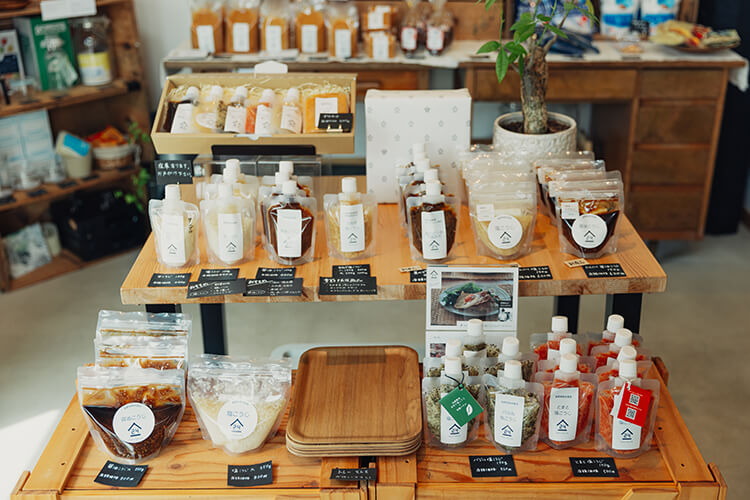
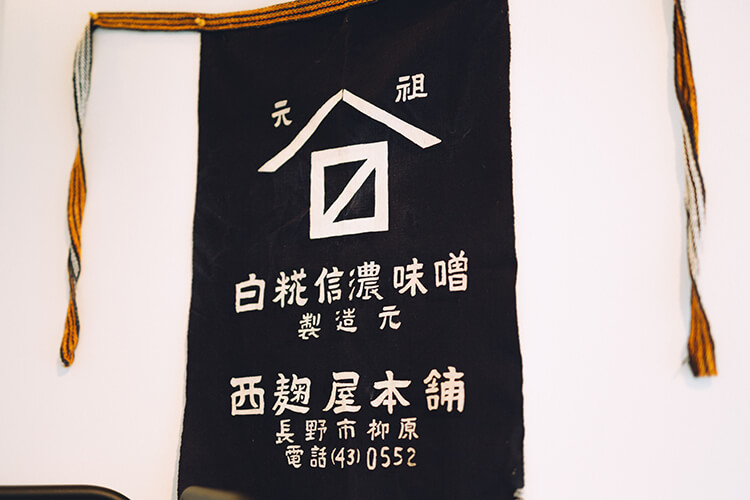
Left: Products displayed on the shelves.
The store is laid out to offer a hands-on shopping experience.
Right: An apron emblazoned with the Nishi Koujiya Honpo logo,
the Yamamasu — a chevron over a square.
“We wanted to attract young people, naturally. We also wanted to create a store that would tempt people to drop by even if they had no interest in koji or miso. The reason we were so fastidious about the design of the packaging was that we wanted to add a dash of excitement to people’s kitchens. Plus we hoped it would make our products nice gifts for the folks back home. Of course, there were elements from the company’s past that we wished to preserve. Nishi Koujiya Honpo is also known by the trade name Yamamasu or ‘chevron-square,’ which refers to our logo of a chevron over a square. We got someone to design a new logo for us by adapting that motif. It consists of a chevron over a stylized murobuta tray. ‘24koujiya’ is written in alphanumeric characters to make the name more visually striking and memorable. It’s also intended to suggest that koji is part of our lives twenty-four hours a day.”
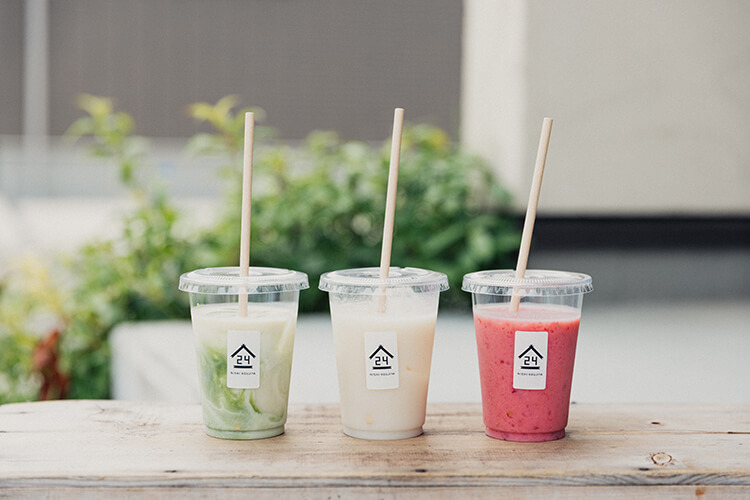
Milk Amazake/Matcha (left), Plain (center), and Soldum Amazake Smoothie (right). Made solely with rice koji, these mildly sweet amazake beverages are a pleasure to drink. They go down all the more smoothly because the grains of rice are well mashed in. In May 2024, the company also opened an amazake shop, Teizo Amazake, in front of the Zenkoji temple.
Yoshihiro became the sixth head of Nishi Koujiya Honpo in 2022, after his father Hirotoshi retired and became chairman.
“We’re a small family-run artisan producer, and I was brought up watching my grandfather and father on the job. I’ve been helping out with the family business since I was a kid, so it was a given that I would take it over one day.”
Today it’s a four-person operation, with the couple and Yoshihiro’s parents all making koji together. Yoshihiro and Masumi married in 2011, and Masumi began helping out after she joined the family. She had previously been under the impression that all Nishi Koujiya Honpo sold was miso.
“I didn’t even know what koji was. When I first realized that koji was this lumpy white substance, I was really amazed. I’d never seen it before. But as I became aware that koji was essential to making fermented foods and beverages like miso, soy sauce, amazake, and sake and started working with it myself, I increasingly fell in love with it.”
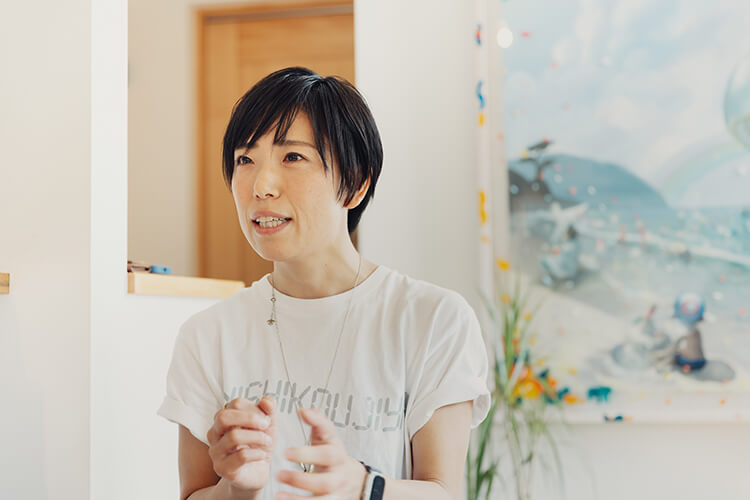
Masumi didn’t know a thing about koji when she first married. After she joined the family, the business struck out in a new direction.
Koji is a malt-like substance produced by growing koji mold on steamed rice or another cereal. Rice inoculated with koji mold is called kome koji or “rice koji.” Soybeans inoculated with koji mold are called mame koji or “bean koji.” What first caught my eye on my visit to Nishi Koujiya Honpo’s factory were the large wooden barrels. So how is koji made? Yoshihiro explains.
“This here is a large steamer for steaming rice, called a koshiki. The steam comes from below. When making rice koji, you steam 120-150 kilograms of rice in one go. Most large factories use stainless steel or aluminum rice steamers. There are very few places that use wooden koshiki like we do. The great thing about wood is that you can properly adjust the moisture content of the steamed rice. With a metal steamer, moisture condenses on the surface, so the rice can end up being too soft.
“After the steamed rice has properly cooled, the koji mold is added. It’s then transferred to a large container called a toko and left to sit overnight. The rice becomes firm as the koji mold spreads over it. So at four or five o’clock the next morning, it’s broken up by hand, then placed into separate murobuta trays.
“Each tray contains about a kilogram, and there are about 120-150 trayfuls altogether. The trays are taken to a small room called the muro, where the koji is grown, and placed on shelves.


Rice steamed in wooden koshiki is transferred to a large container called a toko.
It’s then broken up by hand and, once properly cooled, inoculated with koji mold.
“There they’re left to sit for another night so the koji can grow. Meanwhile, we take painstaking care to control the temperature and humidity in the room. We may adjust the window in the ceiling, turn on the gas heater, or sprinkle the room with hot water so it doesn’t become too dry. It all depends on what our instincts tell us at that particular moment. We keep adjusting the temperature and humidity so they’re just right. That’s how my grandfather and father always did it, and I’ve learned to do the same.
Nowadays, temperature and humidity are controlled automatically almost everywhere. It may be a bit primitive to rely on your physical senses, but when you’ve been at it for long enough, you just know how to do it. Even if you did install, say, a thermometer, it would only tell you the temperature in its immediate vicinity, right? It’s going to be warmer above and cooler below, obviously, so we tend to the koji assiduously by switching around the trays and all that.”

Yoshihiro was brought up watching his grandfather and father on the job. He’s been helping make koji since boyhood.
It takes three whole days to prepare a batch of koji. Other days are spent preparing miso for fermentation or making other products.
“We started making miso in my grandfather’s day, when miso was in considerable demand. For that reason, a lot of people think we’re a miso maker. The fact is, when I took over as president, I thought I might be the last. Wholesaling koji and miso didn’t seem like enough to keep us going. But on my own, I wouldn’t have been able to do something so bold as opening a retail outlet. I owe that to my wife and her decision to become part of the family business.”
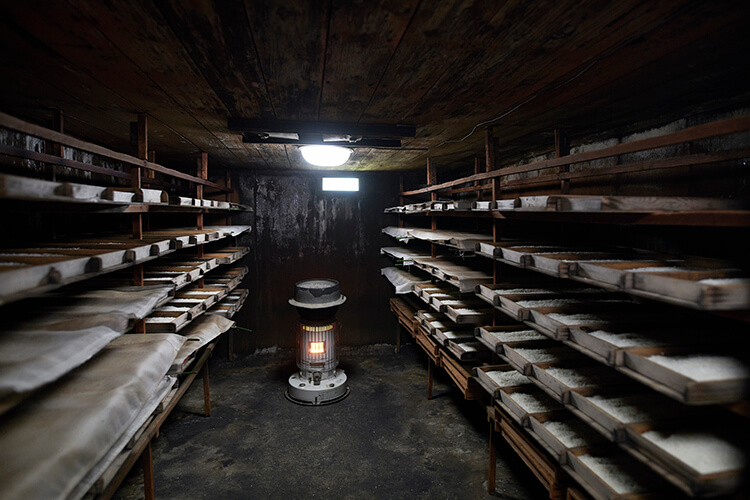
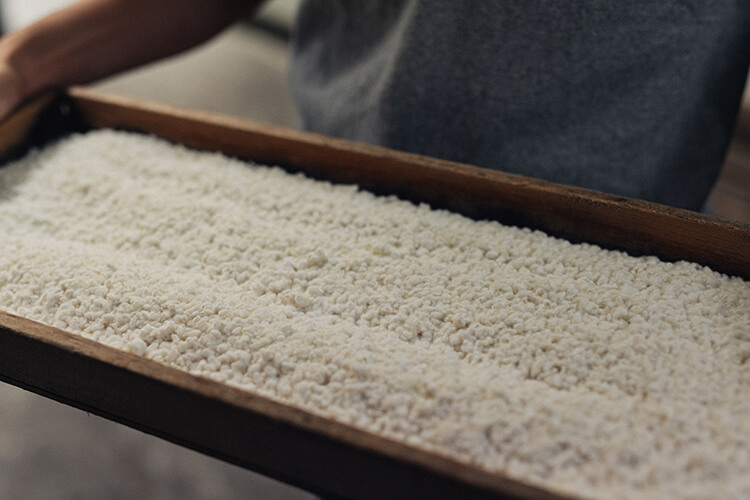
Left: The temperature and humidity of the muro room are adjusted by turning on the gas heater or sprinkling hot water, ensuring the right conditions for koji to grow.
Right: Rice koji coated in fluffy white filaments. Truly a masterpiece of fermentation.
Soon after Masumi started helping out at the factory, the quiet daily routine of making koji and miso was rudely disrupted by the salted koji craze that swept Japan in 2011. This was triggered by the proprietress of a historic koji producer, who revived the shio koji (salted koji) described in a text written in the Edo period. I asked Masumi about salted koji and the craze around it.
“Salted koji is a fermented seasoning made by mixing rice koji with salt and water and aging it for about ten days while stirring it once a day. Koji is, to put it simply, a breaker down of compounds. It contains an abundance of enzymes that break down starch, protein, and fat. Enzymes bring out the flavor of food through their action. They also tenderize ingredients and suffuse them with flavor. Using salted koji thus makes food taste better. It’s an all-purpose seasoning that’s good for your health to boot, which is why it suddenly came into the spotlight. And then things went wild. Virtually overnight, orders from wholesalers shot up tenfold due to the craze. The entire family had to work flat out to keep up. I was expecting a baby at the time, and it was tough having to start work every morning before dawn. The pace was still frenetic after I started parenting, so I guess the craze must have lasted about two years. Things have calmed down now, but koji is better known than it was before the craze. Salted koji and similar fermented seasonings have become market staples.”
While the salted koji craze pushed Masumi beyond her mental and physical limits, it stimulated her desire to learn more about koji.
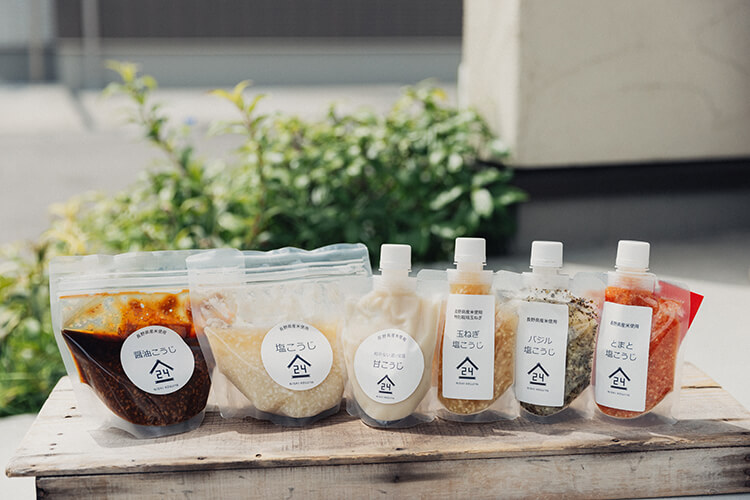
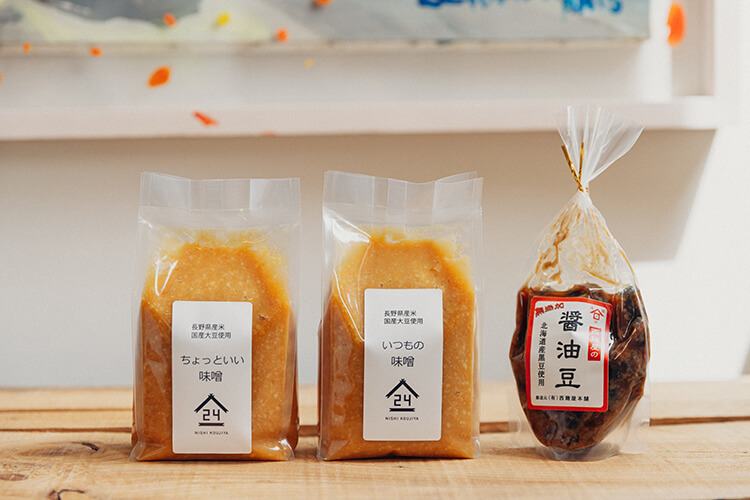
Left: Various fermented seasonings made with koji. Limited-edition seasonal items are also available. From left: Shoyu (Soy Sauce) Koji, Shio Koji, Sweet Koji, Onion Shio Koji, Basil Shio Koji, Tomato Shio Koji.
Right: Also popular is the company’s lineup of misos lovingly produced at its own factory. From left: Fancier Miso, Everyday Miso, and Shoyu Miso, which goes perfectly with rice and makes a great snack with a drink.
“Back then, I had to prepare meals for the whole family every day, and whenever I had a spare moment, I would head to the library and borrow every book I could find. I read voraciously about koji and fermented seasonings. I’d always been interested in traditional foods, and researching koji made me realize how healthy it was. I wanted to improve my diet now that I was pregnant, and I really got into the subject. I didn’t just want book knowledge; I wanted to try making stuff myself. I made salted koji and soy sauce koji, though I sometimes botched it, and started using them in my cooking. Virtually all our family meals consist of miso soup and rice with side dishes, three times a day. Now, the family wasn’t very receptive to new flavors. So with a sweet, innocent look on my face, I would try serving, say, tamagoyaki omelet flavored with ‘Shio Koji,’ which was then a candidate for a new product. Or I would try serving grilled fish flavored with ‘Basil Shio Koji.’ Anything that my family didn’t reject and said tasted good was then commercialized.”
Koji abounds in enzymes, which occur in two forms in the human body. There are digestive enzymes, which make food easier to digest and absorb, and metabolic enzymes, which boost the body’s immunity and natural ability to heal itself. These functions decline with age. One reason fermented foods are considered good for you is their ability to help the body’s enzymes do their job. They improve gut health and boosts immune functions. (Further information can be found on the Fermentation-culture Promotion Agency website.) The fermented foods that attracted the most interest when the craze struck were koji-based fermented seasonings like salted koji.
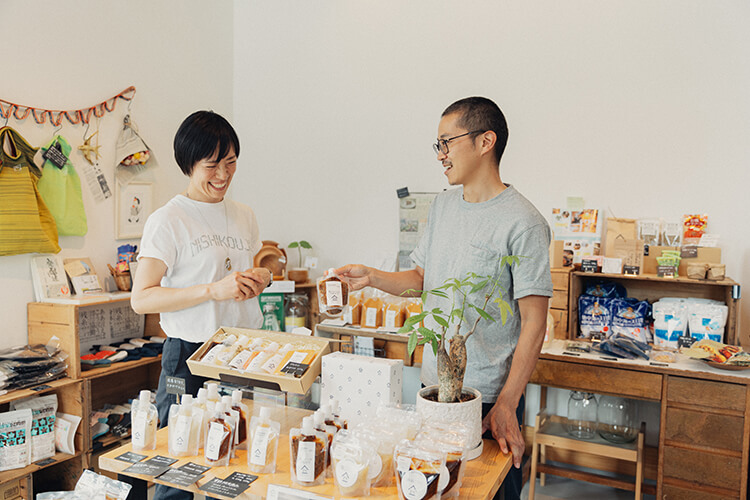
Masumi is the enterprising type, while Yoshihiro is more cautious. Occasionally they get into heated exchanges, but their mutual respect enables them to keep forging ahead together.
The shelves of 24koujiya are lined with various fermented seasonings like salted koji. How can you make these fermented seasonings part of your everyday meal planning? Masumi explains.
“For starters, try substituting them for the condiments you usually use. Use salted koji with tamagoyaki omelet, soy sauce koji with raw egg on rice or fried egg, and sweet koji with yogurt. That will result in a taste experience unlike what you’re used to and increase the food’s umami.
“To give some straightforward examples, simply cut some cucumber into chunks and dress them with salted koji. Or put some soy sauce koji on avocado. They’ll taste deliciously different. To make a dressing, simply mix salted koji with vinegar and olive oil. It actually doubles the umami, so you only need a little, allowing you to cut down on sodium. That’s the great thing about koji. You can also use it in place of store-bought sauces and dips. If you’re going to be using our products, you can use our Basil Shio Koji or Tomato Shio Koji for flavoring pasta. Or add sesame oil to our Shio Koji or Onion Shio Koji to make a dip for reishabu (shabu-shabu served cold).
“These fermented seasonings have an impressive ability to break down proteins, which makes them perfect for seasoning meat and stuff. When making steak or yakiniku (Korean barbecue), massage some into the meat first. That will eliminate the meaty smell, and the meat will turn out tender and delicious when you cook it. Karaage (Japanese fried chicken) likewise tastes completely different if you massage some into the chicken. When making scrambled eggs or omelet, mix a little salted koji into the egg before cooking. It will turn out light and fluffy.”
The Nishizawa family has a rather unusual way of serving one popular Japanese dish.
“We eat sashimi with soy sauce koji and wasabi. A delicious way to enjoy white fish is to massage it with salted koji, then drizzle on sesame oil and top it with chopped perilla leaf. Use one-tenth as much koji as sashimi. Any leftover sashimi can be marinated for a while in soy sauce koji to make a nice sashimi zuke.”
Koji-based fermented seasonings are versatile indeed. The only limit to what you can do with them is your imagination. And they have promising health benefits too. So why not explore the delicious world of koji? Start by using it in the foods you eat every day.
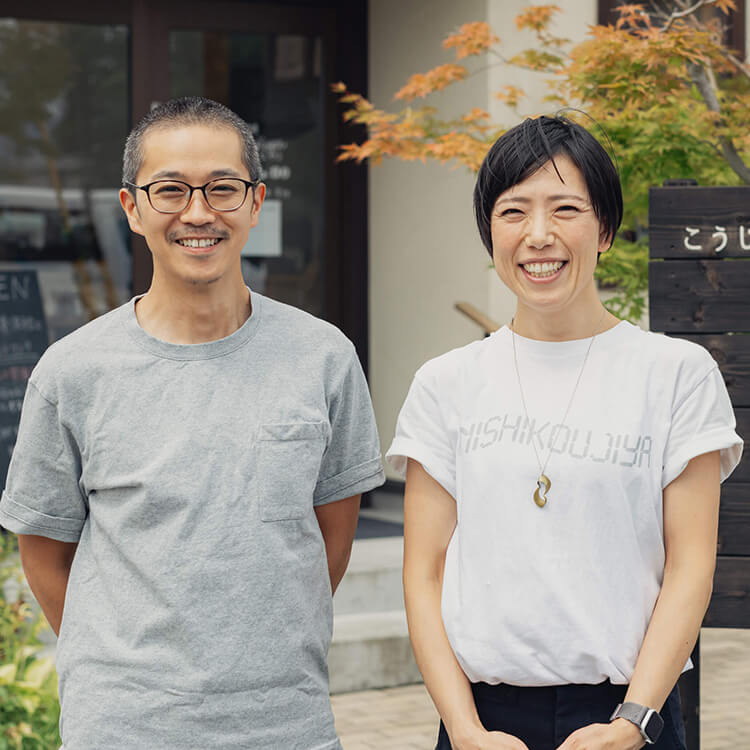
NISHIZAWA Yoshihiro
Sixth in the Nishizawa family line and President of Nishi Koujiya Honpo
Born in 1986, Nishizawa Yoshihiro is a native of the city of Nagano. After graduating from university, he spent a year training at the Nagano Prefecture General Industrial Technology Center. He joined Nishi Koujiya Honpo in 2008 and has been president since 2022. “I’m surprisingly outdoorsy. I enjoy motorcycling, cycling, and camping.”
NISHIZAWA Masumi
Principal, 24koujiya
Born in 1982, Nishizawa Masumi is a native of Chikuma, Nagano Prefecture and married into the Nishizawa family in 2011. She launched Nishi Koujiya Honpo’s online shop in 2017. Then in 2020 she opened the retail outlet 24 koujiya: The Koji Specialists. She opened a second outlet in 2024, Teizo Amazake in the Daimoncho neighborhood of the city of Nagano. “I like spending time enjoying good food and drink with the people I love.”

